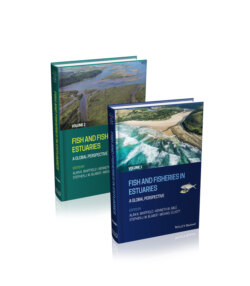Читать книгу Fish and Fisheries in Estuaries - Группа авторов - Страница 38
3.2 Estuarine support of reproduction and recruitment 3.2.1 Replenishment: modes and patterns
ОглавлениеThe observed patterns and behaviours for reproduction are remarkably diverse in estuarine and estuary‐dependent bony fishes (Dando 1984, Blaber 2000, Elliott et al. 2007) as well as in sharks, skates and rays (Musick 2010). The modes of reproduction known in marine and freshwater fishes are represented in estuarine‐occurring species, but many reproduction‐related characteristics are broadly variable amongst biogeographic regions (Table 3.1). Successful reproduction depends on coordinated behaviours and dynamic processes acting on multiple life stages (Blaber 2000, Able & Fahay 2010, Whitfield 2019). Completion of the replenishment process by resident fishes, including recruitment to the adult stock, may be fully accomplished by many small species within the estuary (e.g. fundulids, atherinids, gobiids, blenniids, engraulids). For many elasmobranchs that use estuaries for reproduction, it is primarily for pupping their well‐developed young (Merson & Pratt 2007). In other taxa, adults may migrate from freshwater habitats to brackish estuarine waters to spawn and produce young (e.g. the moronid Morone americana).
Table 3.1 Representative reproductive characteristics of estuarine fishes by broad biogeographical region. Primary sources include Blaber (2000), Elliott & Hemingway (2002), Able & Fahay (2010) and Whitfield (2019).
| Tropical | Subtropical | Temperate/Boreal | Arctic | |
|---|---|---|---|---|
| Spawning stimuli | Watershed flow, salinity, monsoons, temperature | Temperature, dissolved oxygen | Temperature, photoperiod | Temperature, ice conditions |
| Spawning method | Serial spawning over a long season | Serial spawning over a long season | One or few batch spawning over a short season | One or few batch spawnings over a very short season |
| Spawning location | Often continuous between estuary and ocean | Ocean or estuary | Ocean, estuary, freshwater | Freshwater, estuaries and coastal ocean |
| Aspects of reproduction | Ocean: large number of pelagic eggs Estuary: fewer, larger eggs, parental care in some | Ocean: large number of pelagic eggs Estuary: fewer, larger eggs, parental care in some | Ocean: large number of pelagic eggs Estuary: fewer, larger eggs, parental care in some | Rivers: fewer, larger eggs Estuary and coastal ocean: larger number of benthic and pelagic eggs |
| Dominant families | Ariidae Carangidae Clupeidae Elopiformes Engraulidae Gobiidae Haemulidae Mugilidae Polynemidae | Ariidae Carangidae Clupeidae Elopiformes Engraulidae Gobiidae Haemulidae Mugilidae Polynemidae | Clupeidae Engraulidae Pleuronectidae Sciaenidae Sparidae Syngnathidae | Clupeidae Salmonidae Osmeridae Gadidae |
Adults of catadromous taxa leave the estuary or freshwater system connected to it and migrate to sea to spawn (e.g. anguillid eels). Many anadromous fishes migrate as adults from the sea to their natal estuaries or connected tributaries for spawning, with many well‐known examples documented in salmonids (Oncorhynchus spp. and Salmo spp.), moronids (Morone saxatilis) and alosines (Alosa spp.). Some fishes exhibit amphidromy in which adults spawn in freshwaters and tidal estuaries, often depositing eggs in nests (e.g. Plecoglossus altivelis) or on shoreline vegetation (e.g. Galaxias spp.). Their larvae are rapidly advected to sea, returning to estuaries and freshwaters as advanced settlement stages or juveniles where they grow to maturity (McDowall 2007, 2010). Spawning in the coastal ocean is a common reproductive mode for many taxa, for example sciaenids and pleuronectiforms, whose larvae and juveniles immigrate to estuarine nursery areas that support the juvenile stage, often until maturity. In some taxa that use estuaries for reproduction, different life history modes, representing different migratory behaviours and spawning habitat selection, may be represented (i.e. bet‐hedging behaviour; the portfolio effect) (Secor 1999). In such taxa, spawning may occur in more than one habitat type (e.g. some sciaenids, engraulids and clupeids), in which some individuals or cohorts spawn in the estuary while other contingents may spawn in the coastal ocean or both (Able 2005).
Adult spawning behaviours and selection of specific spawning sites initiate the recruitment process. Many species spawn within the estuary itself, either in tidal brackish waters or in the estuary's freshwater headwaters and tributaries (e.g. salmonids, moronids, alosines). Shorelines of estuaries serve as spawning sites for many resident fishes, mostly small species that deposit demersal eggs on hard substrates, in seagrasses or in soft sediments (Able & Fahay 2010, Kraufvelin et al. 2018). Offshore spawning sites for species that spawn there must also be guided by homing behaviour, cueing on oceanographic features and genetic programming, which is especially notable in catadromous fishes (e.g. anguillid eels) but also for species that only travel modest distances to offshore spawning sites, e.g. the sciaenid Micropogonias undulatus, Baltic herring Clupea harengus membras) (Arula et al. 2014), the semi‐catadromous European pleuronectid Platichthys flesus (Amorim et al. 2016) or the centropomid Centropomus undecimalis that spawns in nearshore coastal waters of the Gulf of Mexico close to adult estuarine habitats (Adams et al. 2009). Poor selection of spawning sites or poor timing of spawning that fails to coincide with favourable conditions for egg and larvae survival (Harden‐Jones 1968, Cushing 1975, Secor 2015) has implications for recruitment success. For example, the consequences of misdirected drift of eggs and larvae (the ‘denatant drift’) related to poor selection of spawning sites can result in failure by early‐life stages to reach estuarine nurseries and favourable feeding areas and ultimately recruitment failure (Cushing 1975, 1990, Secor 2002, 2015).
